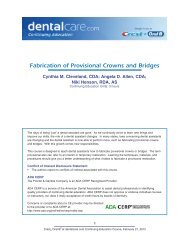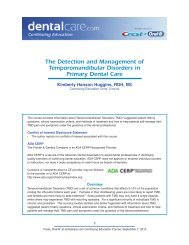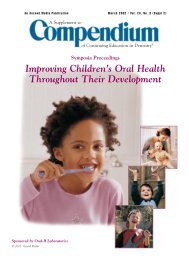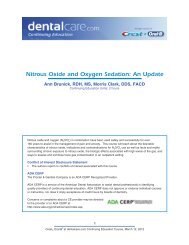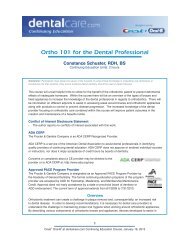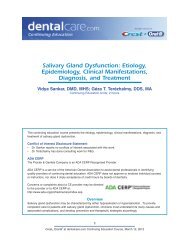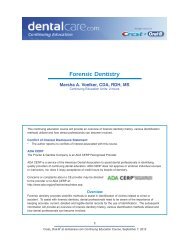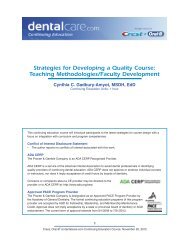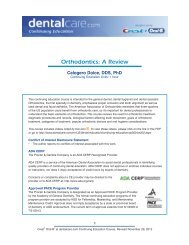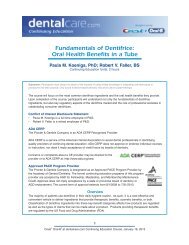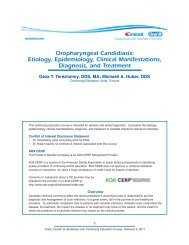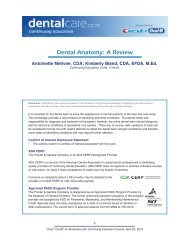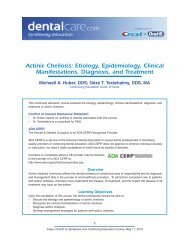CE 391 - Management of Pediatric Medical ... - DentalCare.com
CE 391 - Management of Pediatric Medical ... - DentalCare.com
CE 391 - Management of Pediatric Medical ... - DentalCare.com
You also want an ePaper? Increase the reach of your titles
YUMPU automatically turns print PDFs into web optimized ePapers that Google loves.
exertion, environmental and air pollution.<br />
Psychological and physiologic stress can induce<br />
an attack. The stress <strong>of</strong> disciplinary action by a<br />
parent or entering the treatment area in a dental<br />
<strong>of</strong>fice can trigger an asthmatic attack in children<br />
and adults.<br />
With either type <strong>of</strong> asthma the mechanism for<br />
initiating an attack is the same. The allergen or<br />
non-allergen factors stimulates the vagus nerve to<br />
release acetylcholine which produces constriction<br />
<strong>of</strong> the airways and increased glandular secretions<br />
which plug the small airways in the lungs leading<br />
to bronchial edema and airway obstruction.<br />
The signs and symptoms <strong>of</strong> an acute asthmatic<br />
attack are:<br />
• Shortness <strong>of</strong> breath<br />
• Wheezing and coughing<br />
• Tightness in the chest<br />
• Hypoventilation<br />
• Cyanosis<br />
• Tachycardia<br />
The management <strong>of</strong> an asthmatic patient begins<br />
with the pretreatment history. Ask the patient:<br />
• How attacks occur and their severity<br />
• What triggers attacks<br />
• What medications are taken<br />
If the patient uses a self administered<br />
bronchodilator aerosol during acute asthmatic<br />
attacks e.g. albuterol (Proventil, Ventolin)<br />
isoproterenol (Isuprel) or metaproterenol<br />
(Metaprel, Alupent), they should bring it to their<br />
appointment. The bronchodilators produce<br />
bronchial smooth muscle relaxation. Albuterol has<br />
the least side effects <strong>of</strong> all the bronchodilators and<br />
should be the drug <strong>of</strong> choice for inclusion in the<br />
emergency drug kit.<br />
The steps in emergency management <strong>of</strong> an acute<br />
asthmatic episode are:<br />
• Terminate treatment and remove all dental<br />
materials and instruments from the patient’s<br />
mouth.<br />
• Sit the patient upright or in a <strong>com</strong>fortable<br />
position with the arms thrown forward over a<br />
chair back (Figure 5).<br />
• Administer a bronchodilator supplied by the<br />
patient or from the emergency drug kit. The<br />
directions for use <strong>of</strong> the aerosol inhaler are:<br />
11<br />
The patient holds the inhaler 1 or 2 inches in<br />
front <strong>of</strong> their mouth.<br />
The inhaler is placed in the mouth.<br />
As the patient breaths in slowly through their<br />
mouth, they press down on the inhaler one<br />
time.<br />
The patient continues breathing as deep<br />
as they can and holds their breath for 10<br />
seconds.<br />
Improvement should occur within 15<br />
seconds.<br />
If there is no improvement, the process<br />
should be repeated (Figure 6).<br />
• If after three doses <strong>of</strong> the bronchodilator there<br />
is no improvement, take additional measures:<br />
Administer oxygen<br />
Call for medical assistance<br />
Administer epinephrine 1:1000 concentration<br />
for an adult, 1:2000 concentration for a child.<br />
• If possible, determine the cause <strong>of</strong> the attack<br />
(anxiety, air contaminants)<br />
• If the attack is resolved quickly, the patient<br />
may be discharged on their own. If medical<br />
assistance or the administration <strong>of</strong> epinephrine<br />
is necessary, the patient should be discharged<br />
to emergency medical services for transport to<br />
the hospital.<br />
Anesthetic Toxicity (Overdose)<br />
While rare in adults, young children are more<br />
likely to experience toxic reactions because <strong>of</strong><br />
their lower weight and immature physiology. Most<br />
Figure 5. Patient sitting upright in<br />
<strong>com</strong>fortable position with arms crossed<br />
forward over a chair back.<br />
Crest ® Oral-B ®<br />
at dentalcare.<strong>com</strong> Continuing Education Course, May 11, 2012



